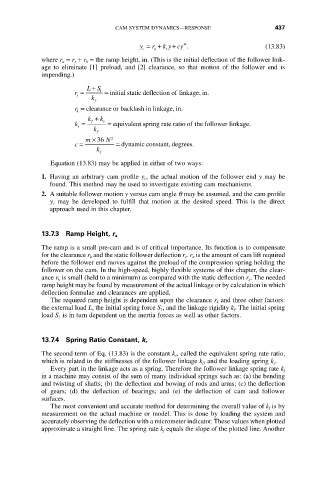Page 449 - Cam Design Handbook
P. 449
THB13 9/19/03 7:56 PM Page 437
CAM SYSTEM DYNAMICS—RESPONSE 437
+
y = r + k y cy¢¢. (13.83)
c a r
where r a = r s + r k = the ramp height, in. (This is the initial deflection of the follower link-
age to eliminate [1] preload, and [2] clearance, so that motion of the follower end is
impending.)
+
LS
r = 1 = initial static deflection of linkage, in.
s
k f
r = clearance or backlash in linkage, in.
k
k + k
k = f s = equivalent spring rate ratio of the follower linkage.
r
k
f
m ¥ 36 N 2
c = = dynamic constant, degrees.
k
f
Equation (13.83) may be applied in either of two ways:
1. Having an arbitrary cam profile y c , the actual motion of the follower end y may be
found. This method may be used to investigate existing cam mechanisms.
2. A suitable follower motion y versus cam angle q may be assumed, and the cam profile
y c may be developed to fulfill that motion at the desired speed. This is the direct
approach used in this chapter.
13.7.3 Ramp Height, r a
The ramp is a small pre-cam and is of critical importance. Its function is to compensate
for the clearance r k and the static follower deflection r s. r a is the amount of cam lift required
before the follower end moves against the preload of the compression spring holding the
follower on the cam. In the high-speed, highly flexible systems of this chapter, the clear-
ance r k is small (held to a minimum) as compared with the static deflection r s. The needed
ramp height may be found by measurement of the actual linkage or by calculation in which
deflection formulae and clearances are applied.
The required ramp height is dependent upon the clearance r k and three other factors:
the external load L, the initial spring force S 1, and the linkage rigidity k f. The initial spring
load S 1 is in turn dependent on the inertia forces as well as other factors.
13.7.4 Spring Ratio Constant, k r
The second term of Eq. (13.83) is the constant k r, called the equivalent spring rate ratio,
which is related to the stiffnesses of the follower linkage k f, and the loading spring k s.
Every part in the linkage acts as a spring. Therefore the follower linkage spring rate k f
in a machine may consist of the sum of many individual springs such as: (a) the bending
and twisting of shafts; (b) the deflection and bowing of rods and arms; (c) the deflection
of gears; (d) the deflection of bearings; and (e) the deflection of cam and follower
surfaces.
The most convenient and accurate method for determining the overall value of k f is by
measurement on the actual machine or model. This is done by loading the system and
accurately observing the deflection with a micrometer indicator. These values when plotted
approximate a straight line. The spring rate k f equals the slope of the plotted line. Another

